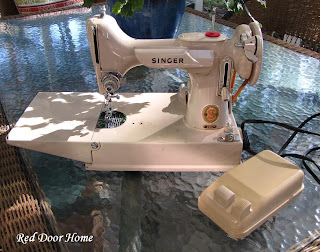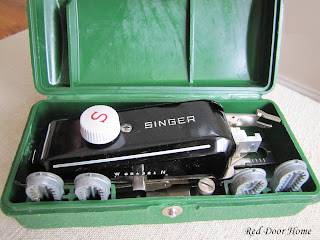Some of the most frequently asked questions I receive in reference to my tutorials are about my sewing machine. Is that really your sewing machine? Is that your only sewing machine? Did you really use that sewing machine to make ….? The answer is yes, yes and yes! I inherited my Singer Featherweight 221 many years ago. It belonged to my Aunt. Although I have looked at (and drooled over) other bigger and fancier machines, I have yet to purchase a new sewing machine.
After some research, I discovered these machines were made from the mid 1930’s to the early 1960’s. They are decorated differently depending on the time period in whch they were made. Featherweights sew only straight stitches (forward and backward) and are made with all-metal parts. Weighing in at around 11 lbs they are still a favorite among quilters today because of their portability. Here are some of the ads Singer used when these machines first appeared on the market.
My mother also owns and still uses the Singer Featherweight she received when graduating from high school. My sewing machine was made in Elizabethport, New Jersey while her machine (shown below) was made in Canada.
By looking at the serial number, I was able to determine my sewing machine was manufactured around April 22, 1954. Unfortunately, there is no data for machines built in Canada.
I was fortunate that my machine came with the original books, a buttonholer, automatic zigzagger, and a variety of other accessories including an edge stitcher, ruffler, binderfoot, zipper foot, hemmer foot and more.
I am embarrassed to say, in all the years I have owned my sewing machine I have not yet tried one of these attachments or most of the accessories. I will have to change this!
Thanks to everyone who asked these and other questions relating to my sewing machine. It gave me (and hopefully you) the opportunity to learn something new. If you ever come across one of these machines, I highly recommend purchasing it. I have used it countless hours and never once have I had a problem. These machines are so well made. I plan on passing my Featherweight down to my daughter.
For additional information about Singer Featherweight sewing machines visit singer-featherweight.com













I just started following your blog today and saw this post. My sewing machine is one I inherited from my grandmother - it's a Singer "Rocketeer" machine, I think from around 1962 or 1963. I was REALLY fortunate that I also inherited the sewing table that it came with, which makes setting up to sew so much easier! And like yours, mine still had the original instruction book which has been so helpful. And the cabinet drawers were full of all kinds of vintage goodness - threads, bobbins, sewing books. I love it!
ReplyDeleteMy Mom has the exact same machine. I can't tell you how many lavendar satchels I made with it when I was younger.
ReplyDeleteThey don't make things like they used to! I'd say that Singer is a KEEPER!
ReplyDeleteThat is so cool - I have a singer from the 60's and Megan does all her sewing on a vintage one too. They are built like old work horses. These new gizmos have too many bells and whistles for me. All the best, Lori
ReplyDeleteWhat a great post! You are so lucky to have one of those workhorses to call your own. Such a beautiful machine!
ReplyDeleteEllen
This sewing machine is quite vintage. Theres a recent post in blogland about a sewing machine display. Ive even seen a cake made to look like a sewing machine. Enjoy everything.
ReplyDeleteMr. Goodwill Hunting
http://g-w-hunting.blogspot.com
I'm the lucky owner of two featherweights, both acquired (cheap) at yard sales, so keep your eye out for them, they are out there! One is from the fifies, the other was made in the thirties. I've owned other newer, fancier machines, but definitely prefer sewing on a featherweight. I also have the attachments and have never used them either! With care, these machines are definitely made to last many lifetimes!
ReplyDeleteI am a quilter and I would jump through hoops of fire to get my hands on a featherweight! I keep hoping that some day I will find one at a yard sale for a reasonable price. You have a real treasure!!
ReplyDeleteI have a featherweight that originally belonged to my great grandmother. Sher bout it in 1934. My mother got it in 1952 when she died. I learned to sew on it and mother gave it to me. I want to tell you that you really should use the buttonholer. It makes the best buttonholes I have ever seen. I love it.
ReplyDeleteI had the same machine (a 1951 model, just like me). I had that same little green case and booklet, but alas it died quite a few years ago. I am embarrassed to say that I bought a new basic Singer and have yet to try it because I am afraid I won't be able to thread it or wind the bobbins...what is wrong with me???
ReplyDeleteLove your blog and your style.
I think I have the same machine! I'll have to dig it out and see! Too funny!
ReplyDeleteDebbie